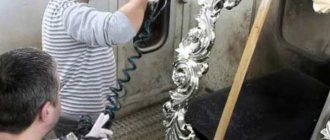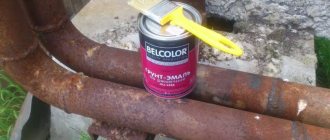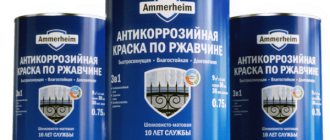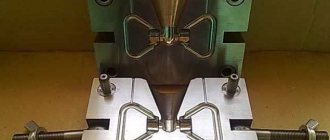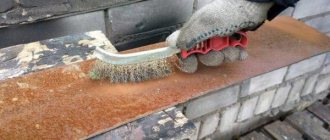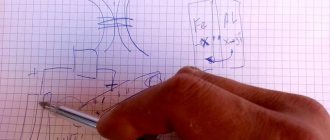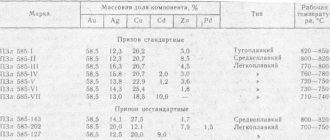Copper plating is the process of applying a copper layer to the surface using an electroplating method.
The copper layer gives the product visual appeal, which allows the use of copper electroplating in design projects. It also gives the metal high electrical conductivity, which allows the product to be subjected to further surface treatment.
Copper plating can be used as the main process to create a surface layer, and also as an intermediate operation for the subsequent application of another metal layer. This method includes, for example, the process of silvering, chrome plating or nickel plating.
Copper plating can be done at home. This makes it possible to solve many everyday problems.
Electroplating with copper at home: general information
From a technical point of view, processing is an electrochemical process. There are always two “participants” in the process: the anode + electrolyte (metal source) and the part.
The technology of copper electroplating at home is quite simple. It consists in the fact that due to the electrolyte and the current conducted through it, metal atoms are released. They settle on the surface, forming a copper coating.
Among the main stages of electroplating copper plating at home:
- Surface preparation (mechanical and chemical).
- Applying an undercoat (if necessary)
- Copper plating in an electrolyte corresponding to the original metal.
For decorative galvanic copper plating, matte and shiny copper plating electrolytes are suitable. After applying the layer, you can treat the surface in electrolytes of silver, gold, nickel, etc.
Process concept
Copper plating is a procedure in which a small layer of copper is applied to the surface of an object. Typically, a galvanic method is used, which involves the transfer of copper ions from a positive to a negative source to the surfaces being treated. As a rule, copper plating is carried out for the subsequent application of nickel or chromium, but often this procedure becomes an independent technological operation for the final finishing. This is an actively used electroforming process that requires the creation of a copper coating.
Necessary tools for copper plating at home
“Ingredients” without which copper plating will not take place, but which can actually be prepared at home. Our galvanists claim that, first of all, we need:
- DC source. Selected depending on the size of the product.
- Anodes. Anode plates perform several functions. First of all, they supply current to the electrolyte, and secondly, they compensate for the loss of metal that goes into coating the product.
- Working electrolyte. Acidic, alkaline or pyrophosphoric solution. The composition of the electrolyte is selected depending on the starting metal. It must be remembered that any electrolyte is not universal and is not suitable for all jobs.
Characteristics of copper-plated metals
Under the influence of atmospheric factors, it quickly deteriorates, and even at home it is usually coated with varnish. At the same time, the copper sublayer significantly improves the characteristics of multilayer coatings in terms of mechanical strength and corrosion resistance.
Stainless steels are typically protected from corrosion by a three-layer coating of chromium, nickel and copper. In this case, copper plating is carried out first in order to ensure the ductility of the entire composite layer when using the product under conditions of variable loads.
Copper plating plays exactly the same role in coatings of rolled metal and sheet iron, from which profile products are made that are used in marine climates and aggressive environments. Copper-plated wires and aluminum contacts are easy to solder and have lower resistance, especially at high frequencies.
The technical conditions of electrolysis make it possible, when copper plating metals for decorative purposes, to paint the surface layers of copper in various colors and give them additional shine (in the photo below - copper plating on stainless steel).
Preparation of material
How to properly prepare a simple copper plating electrolyte
It is worth noting that electroplating with copper at home is difficult because the chemicals are not easy to find. Companies selling such products do not sell them without special documents. But you can do everything yourself.
It is possible to prepare electrolyte at home only if the recipe is strictly followed. The simplest electrolyte contains:
- Distilled water (or bidistillate).
- Copper sulfate.
- Hydrochloric or other acid.
The finished solution has a bright blue color and no odor. Some sediment may be present. It is important to follow all safety precautions with chemical reagents, especially at home: protect your hands and eyes first. Clothes on which the solution could accidentally spill are best classified as summer clothes.
It is better to store such liquid in glass bottles or plastic canisters, and be sure to indicate the date of bottling and the name of the solution. Proper storage of components will save you from possible problems. Electrolyte preparation should take place in clean plastic or glass containers.
Preparing material for copper plating at home
Chemical copper plating is an alternative to the electrochemical method, but cannot always replace it. In this process, it is important to carefully prepare the part, completely eliminating scratches, dirt, chips, etc. In order to degrease an item, you can use both pure solvents and degreasing solutions.
However, there is no universal method - different types of metal are cleaned in different ways:
- Steel. You can degrease steel with a solution containing caustic sodium and caustic potassium at 70-90 degrees Celsius. This will take about 20-30 minutes. Be careful and use a hood.
- Copper and alloys. Degreasing is carried out with sodium hydroxide, preheated to 40°, for about 10 minutes.
- Cast iron. The degreasing process requires a solution containing sodium hydroxide, liquid glass, sodium carbonate and sodium phosphate when heated to 90°.
- Tungsten. Copper plating of tungsten at home begins with cleaning the object from dirt and other defects with sandpaper.
Safety precautions for copper plating at home
Despite the possibility of electroplating at home (copper plating), the process remains dangerous. Any galvanic process involves toxic substances that can become very hot. Therefore, precautions must be strictly observed.
The first rule of copper electroplating at home is to work only in a non-residential, well-ventilated area. Places such as a workshop or garage are suitable. The second rule is that the equipment used must be grounded. Third is personal safety.
To ensure your own protection when copper plating at home you need:
- Wear a respirator at all times to protect your airways. It is best to use a hood.
- Protect your hands with durable rubberized gloves.
- Wear a special uniform or oilcloth apron and anti-burn shoes.
- Don't forget glasses for visual safety.
- Do not bring food or drink into the premises.
Before copper plating, it is better to take care of reading specialized literature on this topic in advance. It is advisable to consult with specialists in this field.
Electroplating at home: copper plating
Why is copper so popular in electroplating? It has high adhesion (in other words, grip) to a wide variety of materials. This means that it adheres perfectly to products made of steel and tungsten, without flying off or chipping.
Copper is a beautiful bright metal that looks like pink-red nuggets. The material conducts not only heat, but also electric current - hence the high demand in the field of electrical engineering and instrument making. However, pure copper is difficult to find. More often it comes with various impurities.
Copper coatings:
- They are characterized by low resistance, which is used in electrical engineering
- Hides minor surface imperfections.
- It oxidizes quickly, which is used to obtain an “antique” effect.
There are two copper plating technologies. One occurs by immersing the product in an electrolyte solution (with or without current supply). The second method is a method of selective coating without immersion in a solution. Let's look at both.
Immersion method
At home, the surface to be electroplated should be carefully treated. For example, sandpaper and a brush. Afterwards, be sure to degrease the part and rinse it.
Further:
- The anode plate (two are possible) is placed in a container, which we will call a bath. The positive terminal is connected to the anodes.
- A part is suspended between the anodes on any convenient conductor, and the negative pole from the power supply is connected to it.
- The finished solution is poured into the bath - in this case, the coating level should be higher than the part is located.
- After connecting the electrodes to the current source, the operating current is set. This is approximately 1 A/sq.dm. coverings.
The duration of work depends on the required layer thickness, usually from 5 minutes.
Non-immersion coating
This method of copper plating has limitations - most often it is suitable for surface restoration. This method can only apply a small thickness of metal. There is no point in coating products using this method that can be copper plated in a bath. Procedure for galvanic copper plating at home:
- A “tampon” is prepared for applying the coating. Take a copper conductor and wrap a piece of artificial fabric (polyester is fine).
- The opposite end of the conductor is connected to the positive terminal of the voltage source.
- Fill the container with an electrolyte solution - this makes it easier to dip the pencil.
- The part is carefully cleaned and degreased, and then placed in an empty bath. There the product is connected to the negative terminal.
- The swab is moistened in the solution. Then it is passed over the surface of the product, painting it gradually.
The process lasts until the product is completely covered with a copper layer.
The purpose of copper plating of metals and their scope of application
Copper has a set of properties that determine the conditions for its use in copper plating of metals and non-metallic materials. It is plastic, easy to polish, and the galvanic layer after copper plating has virtually no pores.
For this reason, copper coatings are very often used as a sublayer for chrome and nickel plating of products that are operated under conditions of constant compression and tension. The ductility of copper is an ideal condition for its use in electroforming.
Thick-layer copper plating of artistic products and complex models allows you to create their absolutely exact copies that do not crack or deform when removed from the original.
Copper has the best electrical conductivity among base metals and is easily soldered. Therefore, copper plating of steel products is widely used in radio engineering and electrical engineering in the manufacture of conductors, contacts, antenna parts and waveguides.
When high-frequency signals are used, the copper coating experiences a high current density (skin effect), which reduces the overall resistance of the conductor.
Another area of use of copper plating is the creation of thin conductors on the surfaces of plastic products, as well as the coating of plastic with conductive layers.
Features of galvanoplasty at home
Electroplating is the process of depositing copper onto a conductive or non-conductive surface of a product and then removing the coating from the negative matrix. This way you can get many very accurate copies from one product. At the same time, there is a condition: build up copper with a thickness of at least 200 microns so that the product turns out durable.
It is important to consider that if the surface of the product does not have conductor properties, then more effort will be required - namely, a special preliminary coating with graphite, silver or copper. Copper is considered the main metal for electroplating, but matrices can be grown from silver with a purity of 9999.
Electroplating training
We can conclude that copper plating today is one of the most relevant electroplating processes that anyone can learn. conducts training in the field of "Galvanics" for everyone! You will be able to choose a training program that is convenient for you, which is best suited for electroplating at home and beyond. All questions you may have can be asked by phone or email; our technologists will advise you on training courses.
Video guide to copper plating parts at home:
You can find out more details at the link:
Gordienko Anastasia Vadimovna Author of the materials Position: chief technologist of 6 Micron LLC Education: higher Experience in galvanizing: 13 years
When placing an order online, get a 10% discount!
Our priority is an individual approach to each order and the quality of the work performed!
Send a request or ask a question:
4.1/5 — (594 votes)
